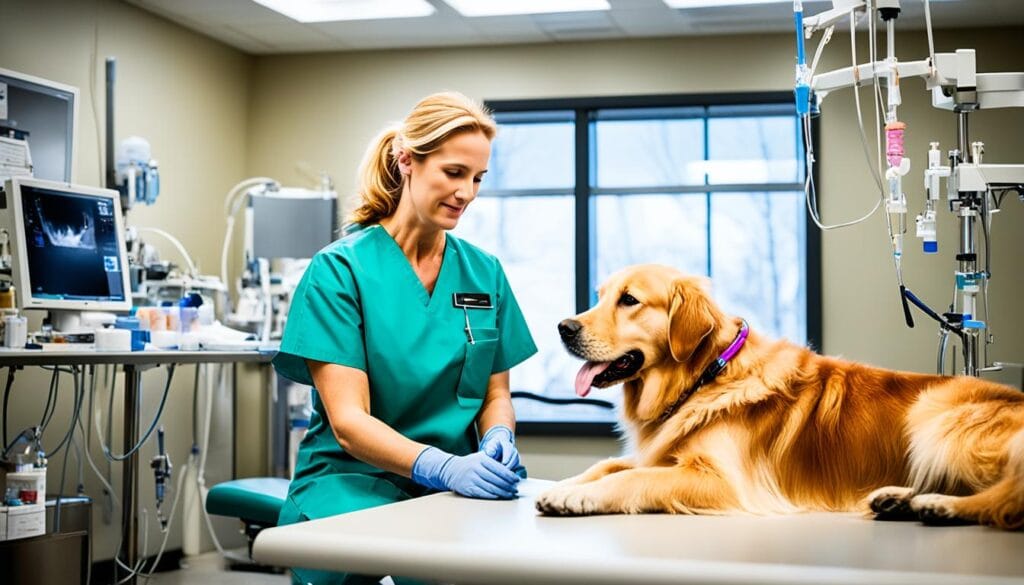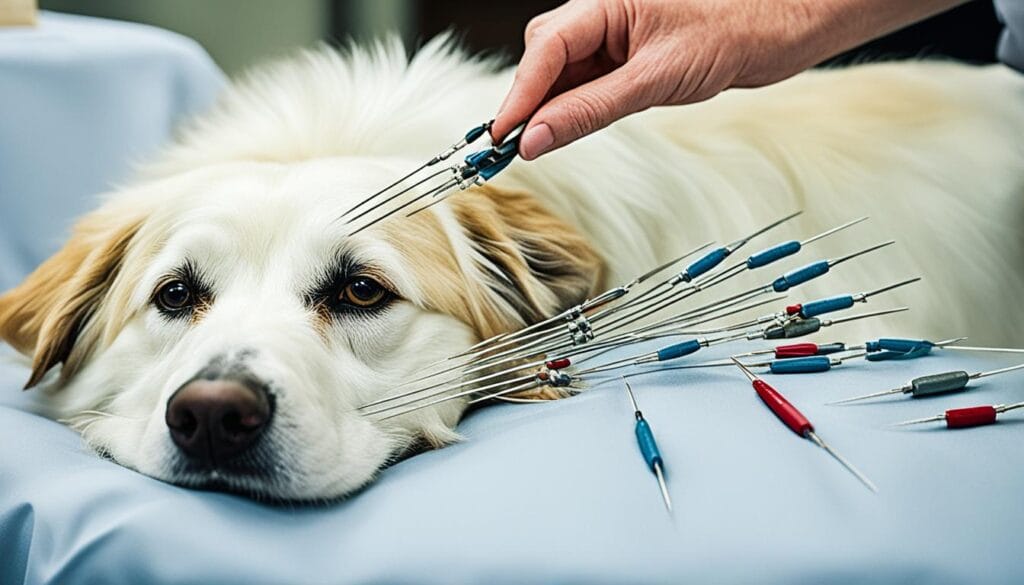Canine lymphoma is a top cancer among dogs, worrying pet parents everywhere. It’s like non-Hodgkin’s lymphoma in people, in how it looks under a microscope and how it’s treated. With up to 20% of new dog cancer cases being lymphoma, learning about its treatments is very important. The Werling Comparative Oncology Research Center is key in making treatments better for dogs and people with lymphoma.
There are different types of lymphoma in dogs, like multicentric and alimentary, which grow and spread differently. They usually start in the lymph nodes but can reach the spleen, liver, or bone marrow. The Purdue University Small Animal Hospital is known for its great care that’s needed for dogs with lymphoma.
For dogs with B-cell lymphoma, the outlook is usually better than for those with T-cell lymphoma. B-cell lymphoma often responds well to treatments, and dogs may live around 12 months longer. But, T-cell lymphoma dogs might only live 6 to 9 months with the best care.
Key Takeaways
- Canine Lymphoma Treatment.
- Canine lymphoma is much like non-Hodgkin’s lymphoma in how it reacts to chemo.
- B-cell lymphoma usually has a better outcome than T-cell lymphoma.
- B-cell lymphoma treatments can sometimes add 12 more months to a dog’s life.
- Top cancer centers for dogs, like Purdue University, offer full support.
- About 80-85% of lymphoma in dogs is multicentric.
Understanding Canine Lymphoma
Canine lymphoma is a wide range of cancers that attack white blood cells. It mostly affects organs in the immune system. Lymphoma makes up 7-14% of all dog cancers and can show up anywhere in their body.
What is Canine Lymphoma?
In dogs, lymphoma means lymphocytes, a vital type of white blood cell, grow out of control. This disease often looks like non-Hodgkin’s lymphoma in people. Both have similar looks under a microscope and react well to chemotherapy.
Types of Canine Lymphoma
There are more than 30 types of this disease. The most common is multicentric lymphoma, making up 80-85% of cases. There are also other important types like:
- Cutaneous lymphoma: This shows up on the skin as tumors or lesions.
- Alimentary or gastrointestinal lymphoma: It’s the second most common, affecting the stomach and gut. This causes issues like throwing up and diarrhea.
- Mediastinal lymphoma: It’s in the chest, affecting the heart area or thymus gland.
B cell lymphoma makes up most cases, about 70-80%. T cell lymphoma is less common, at 20-30%.
Symptoms of Lymphoma in Dogs
Lymphoma symptoms can vary by type and how far the disease has spread. Signs may include:
- Enlarged lymph nodes
- Loss of appetite
- Lethargy
- Swelling
- Increased thirst and urination
As it gets worse, lymphoma’s symptoms can become very serious. This highlights the need for spotting it early and getting help.
This cancer is more common in older dogs. Some breeds, like Chow Chows, Golden Retrievers, and German Shepherds, tend to get it more. But treatments like chemo often work well, offering a lot of hope.
Stages and Progression of Lymphoma in Dogs
It’s key to categorize lymphoma in dogs into stages to grasp its growth. The five stages show how much the disease has spread. This helps understand what might work best for treatment.
Stage I: Single Lymph Node
In Stage I, lymphoma hits just one lymph node and is the least advanced. Catching it early gives a good chance for the dog to recover. Treatments here usually involve a biopsy and focused chemo.
Stage II: Multiple Lymph Nodes on One Side
By Stage II, the disease affects many nodes but only on one side. Despite spreading, it’s still somewhat contained. Early treatments can make a big difference here.
Stage III: Generalized Lymph Node Involvement
Stage III means lymphoma has spread on both sides of the diaphragm. It’s a clear sign the disease is more widespread. Combining different chemotherapy treatments becomes crucial now.
Stage IV: Liver and Spleen Involvement
In Stage IV, the liver and spleen are part of the disease. The outlook is less certain but treatments can help a lot. Now, a full-on approach with strong chemo and care is needed.
Stage V: Bone Marrow and Other Organs
Stage V is the most severe. Lymphoma has reached the bone marrow and perhaps more organs. Dogs show many symptoms and need very intense care to make life better.
| Stage | Characteristics | Involvement | Treatment |
|---|---|---|---|
| Stage I | Single lymph node | Localized | Biopsy, Chemotherapy |
| Stage II | Multiple lymph nodes on one side | Regional | Early-stage Chemotherapy |
| Stage III | Generalized lymph node involvement | Systemic | Combination Chemotherapy |
| Stage IV | Liver and spleen involvement | Advanced | Aggressive Chemotherapy, Supportive Care |
| Stage V | Bone marrow and other organs | Extensive | Intensive Treatment Strategies |
Fully knowing the stages of lymphoma in dogs helps the vet provide the best treatments. No matter the stage, custom care can improve the dog’s life.
Diagnosis of Canine Lymphoma
The right diagnosis of canine lymphoma is crucial. It affects 7-14% of cancer cases in dogs. The process starts with tests to find signs of the disease in cells. This helps create treatment plans that can make the situation better.
Biopsy and Fine Needle Aspirate
To diagnose canine lymphoma, a vet may do a biopsy or a fine needle aspirate. These let the vet take samples from lymph nodes or organs. Aspirates are quick and done in the office. Biopsies give more tissue but need surgery and anesthesia. Both kinds of samples help tell what kind of lymphoma it is and how to treat it.
Additional Diagnostic Tests
After a biopsy or aspirate, more tests are necessary for a complete view. This can include blood work, urine checks, x-rays, and sonograms. Blood tests reveal health issues and urine checks see how the kidneys are doing. X-rays and sonograms show what’s happening inside without surgery. Sometimes, marrow tests check if the cancer has spread, giving important information.
Immunohistochemistry and Flow Cytometry
New tests like immunohistochemistry and flow cytometry are very helpful. Immunohistochemistry adds color to samples to show cell types, helping with the right treatment. Flow cytometry looks at cell features to identify lymphoma types. These tests are very detailed and are a big help in advanced pet cancer care.
Getting the right diagnosis is key to plan the best treatment. This usually involves more than one method to fully understand the disease. For the latest in lymphoma care, check out canine lymphoma research.
| Diagnosis Method | Description |
|---|---|
| Biopsy | Comprehensive tissue sample, often requiring anesthesia |
| Fine Needle Aspirate | Less invasive sample collection, suitable for in-office procedures |
| Blood Tests | Reveals blood abnormalities and overall health status |
| Urinalysis | Assesses kidney function and detects urinary anomalies |
| X-rays | Visualizes internal structures, identifying organ involvement |
| Sonograms | Non-invasive imaging of internal organs |
| Bone Marrow Aspirates | Determines the spread of cancer to the bone marrow |
| Immunohistochemistry | Uses specific antibodies to identify cell markers in biopsy samples |
| Flow Cytometry | Analyzes physical and chemical properties of cells, characterizing the lymphoma |
Canine Lymphoma Treatment
Canine lymphoma treatments focus mainly on chemotherapy, which is very effective. It’s especially important because about 7-14% of dog cancers are lymphomas. Different lymphoma types, like multicentric lymphoma, need specific treatments. Some get drugs through a vein, while others take pills.
The CHOP plan is the usual method for dogs with multicentric lymphoma. Over six months, dogs receive several chemotherapy drugs. This approach works well, with 70-90% of dogs responding positively. The main aim is to lower cancer cells until they can’t be found anymore.
There are over 30 kinds of canine lymphoma, making each treatment unique. Many dogs with multicentric lymphoma and the CHOP plan have long remission periods. This shows how important it is to treat each dog’s lymphoma based on its specifics.
Other lymphoma types like cutaneous, GI, or mediastinal have different symptoms and need unique treatments. Some might cause skin issues, while others stomach problems. A flexible treatment approach helps improve the dog’s life quality.
With the right care, dogs with lymphoma can have good times ahead. A personalized treatment aiming at the lymphoma’s type and stage can do wonders. It can increase their lifespan and make their life much better.
Chemotherapy for Dogs with Lymphoma
For dogs with lymphoma, chemotherapy is vital. It helps improve remission rates and how long they live.
The CHOP Protocol
The CHOP protocol uses a mix of drugs to fight the cancer. It includes drugs like cyclophosphamide, doxorubicin, vincristine, and prednisone. Over six months, this combination has been proven to help dogs live longer. Recent studies highlight that this method, combined with other therapies, can be even more effective.
Single-agent Therapies
Sometimes, using just one drug is better. For example, lomustine (CCNU) in a pill form works well for dogs with skin cancer. This is a good option for dogs that can’t handle multiple drugs. There are also other drugs, like asparaginase and temozolomide, being tested. They might be used as a backup treatment for different types of lymphoma.
Potential Side Effects
Chemotherapy can be hard on dogs but is often worth it. It might lead to less blood and stomach issues. Serious problems are rare, and dogs usually tolerate it well. How a dog’s body reacts to the drugs can affect their recovery. Owners should know about the possible side effects and keep in close contact with their vet.
Other Conventional Therapies
Chemotherapy is key in treating canine lymphoma. However, vets might also use surgery and radiation. These can help a lot, especially for lymphomas in one spot or certain cases along with chemotherapy.
Surgical Options
Surgery isn’t the main choice for treating lymphoma. That’s because lymphoma often involves the whole body. Yet, for single masses or low-grade lymphomas in one area, surgery could be helpful. It’s used to clear blockages or take out tumors causing specific issues. Doctors carefully think about and choose surgery when it might add to the treatment plan.
Radiation Therapy
Radiation is good for cancers in one area that didn’t spread much or for comfort care. It’s often given with chemo to work better. This treatment is focused, which can mean less medicine throughout the body. This helps the dog feel better during treatment.
Adding surgery, radiation, or chemo together can work better for medium to high-grade lymphomas. Knowing the type of lymphoma, like B-cell or T-cell, is important. This shapes the right treatment plan. Treatments like Laverdia-CA1 also offer good choices. They balance how well they work with managing side effects.
When picking a treatment, the dog’s health and the cancer stage are most important. The goal is to use the best mix of treatments. This leads to the best results for the dog.
Holistic Treatment for Dog Lymphoma
Holistic treatments help your dog fight lymphoma. They focus on the dog’s overall health, not just the cancer. Changing the dog’s diet is a big part of this. A diet low in carbs and rich in Omega-3 can reduce inflammation. This is important for dogs with lymphoma.
Fish oil, a source of Omega-3, is great for lessening inflammation. It also helps the immune system work better. OncoPet Cancer Vitamin with polyphenols and antioxidants also boosts immunity.
Eating fresh foods with probiotics and prebiotic fibers supports a strong immune system. Resveratrol, found in plants, is an antioxidant. It stops cancer in different stages, aiding prevention and support.
Holistic care for lymphoma uses multiple treatments together. Happy Paws Organic Hemp Extract reduces inflammation and helps the immune system. These treatments aim to slow cancer growth and lengthen life.
Cost is a big factor in choosing holistic care over traditional medicine. Treatments like CHOP might cost $5,000 to $7,000 in six months. Holistic care can be more affordable over time, making it an attractive choice. It’s also more flexible and easier to access in some areas.
Conventional treatments fight cancer directly. But holistic care makes the dog’s body stronger to fight itself. Many prefer holistic care to avoid the side effects of chemo and toxins.
Commercial dog foods may not be the best for dogs with lymphoma. A good diet and avoiding harmful chemicals can boost the immune system. Holistic methods target overall health, improving the dog’s life while fighting lymphoma.
Prognosis and Remission in Canine Lymphoma
Knowing about a dog’s lymphoma prognosis is very important. It helps in giving the right care and setting goals for the pet’s wellness. Many things affect how long a dog with lymphoma might live. This includes the type and treatment.
Survival Rates
Survival rates for canine lymphoma depend on what treatment is given. For instance, the CHOP treatment has helped 70-90% of dogs go into remission. The time a dog might survive can be between several months and over a year. Info from the Animal Tumor Registry of Genoa, Italy is key to understanding how common this cancer is.
| Classification Type | Average Survival Time |
|---|---|
| B-cell Lymphoma | 12-18 months |
| T-cell Lymphoma | 6-9 months |
Factors Affecting Prognosis
Many things can change the prognosis for canine lymphoma. This includes the type (B-cell or T-cell), the stage when it was found, and how the dog reacts to treatment. T-cell type is usually more aggressive, with shorter survival times than B-cell. Standardized criteria and university studies help to understand these differences.
Also, the type of treatment can matter a lot. For example, comparing COAP and UW-19 treatments shows us what works better. Giving chemo more intensely might make remission last longer. But it could also bring more side effects.
Survival chances for dogs with lymphoma can vary a lot. This makes personalized treatments very important. We should consider each dog’s unique case for the best results. The goal is to help dogs live longer and better.
Quality of Life Considerations
Helping a dog through lymphoma treatment means looking at how their life is affected. We manage side effects, offer emotional support, and watch their diet closely. All these steps are important for their well-being.
Managing Side Effects
Lymphoma treatments can cause issues like vomiting and diarrhea. These must be handled well to keep the dog happy. Chemotherapy’s side effects are usually mild, but close monitoring is vital. Regular talks with the vet can quickly solve any problems. This helps keep the dog’s life steady and calm.
Supporting Your Dog Emotionally
It’s crucial to emotionally support a dog fighting lymphoma. They can feel stressed and need extra love. Playtime, a quiet home, and a strict routine can make a huge difference. This kind of environment helps them face the disease’s challenges.
Diet and Nutrition Tips
The right diet is key in fighting lymphoma for dogs. A diet designed for their needs improves immunity and energy. Including proteins, healthy fats, and antioxidants fights the disease’s effects. A vet nutritionist can make a diet plan suited just for them.
| Key Consideration | Statistics |
|---|---|
| Quality of Life during Treatment | 68% of owners: Same quality of life; 32%: Acceptable but poorer |
| Treatment Complications | 52% of owners reported complications |
| Owner Satisfaction | 92% had no regrets about treating their pet |
Conclusion
Treating canine lymphoma is complex. It combines top medical care with emotional and mental support. Research on treatment methods like COAP and UW-19 for multicentric lymphoma is showing promise. This research aims to boost survival and improve the dog’s quality of life.
Chemoimmunotherapy has been studied since 1977. New methods like genetic vaccines targeting telomerase and chemo are bringing hope. Also, studies on radiotherapy for oral lymphomas and adoptive T-cell therapy are promising. They show different ways we can fight lymphoma in dogs, helping them live longer.
There’s a link between human and dog lymphomas. This tells us that more research and teamwork are needed. By keeping up with the latest studies, vets can offer advanced and caring treatments. These treatments help the dog not just physically but emotionally too. It ensures a full approach to treating lymphoma in dogs.




















